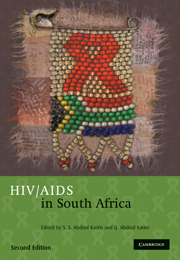Book contents
- Frontmatter
- Contents
- List of Contributors
- Foreword: Peter Piot
- Foreword: Nelson R Mandela
- Acknowledgements
- Section 1 Birth of a rapidly growing epidemic
- Section 2 The virus, the human host and their interactions
- Section 3 HIV risk factors and prevention strategiess
- Section 4 Focal groups for understanding the HIV epidemic
- 17 Heterosexual transmission of HIV – the importance of a gendered perspective in HIV prevention
- 18 Young people and HIV/AIDS in South Africa: prevalence of infection, risk factors and social context
- 19 Female sex workers
- 20 Population movement and the spread of HIV in southern Africa
- Section 5 The impact of AIDS
- Section 6 Treating HIV
- Section 7 What does the future hold?
- Index
17 - Heterosexual transmission of HIV – the importance of a gendered perspective in HIV prevention
Published online by Cambridge University Press: 07 September 2011
- Frontmatter
- Contents
- List of Contributors
- Foreword: Peter Piot
- Foreword: Nelson R Mandela
- Acknowledgements
- Section 1 Birth of a rapidly growing epidemic
- Section 2 The virus, the human host and their interactions
- Section 3 HIV risk factors and prevention strategiess
- Section 4 Focal groups for understanding the HIV epidemic
- 17 Heterosexual transmission of HIV – the importance of a gendered perspective in HIV prevention
- 18 Young people and HIV/AIDS in South Africa: prevalence of infection, risk factors and social context
- 19 Female sex workers
- 20 Population movement and the spread of HIV in southern Africa
- Section 5 The impact of AIDS
- Section 6 Treating HIV
- Section 7 What does the future hold?
- Index
Summary
THIS CHAPTER PROVIDES A brief overview of the global burden of heterosexually transmitted HIV, the role of age, gender, migration and sexually transmitted infections as key factors driving the epidemiology of HIV transmission and some of the underlying biological mechanisms for the heterosexual transmission of HIV. Specific societal and economic factors that shape masculine and feminine identities, and contribute to differences in the risk of acquiring infection heterosexually between men and women, are presented. Within this context the limitations of the current paradigm of HIV prevention, namely abstinence, behaviour modification and use of male condoms are also considered. These data show that acquisition and prevention of sexual transmission of HIV is a multi-factorial and complex social and biological challenge. If we are to make an impact on the current trajectory of this epidemic we will need to adopt more gender-sensitive approaches in all aspects of our response to the HIV epidemic. In conclusion, the approaches for achieving this are highlighted.
Heterosexual transmission of HIV
Some indication of the importance of the heterosexual component of the global burden of hiv infection is shown by the unaids estimates at the end of 2007. Of the estimated 33 million prevalent infections, about 84% were acquired through heterosexual transmission. Further, of the 2.7 million new infections and 2.0 million aids deaths in 2007, over 85% were in people who acquired hiv infection heterosexually.
- Type
- Chapter
- Information
- HIV/AIDS in South Africa , pp. 285 - 304Publisher: Cambridge University PressPrint publication year: 2010
- 4
- Cited by



